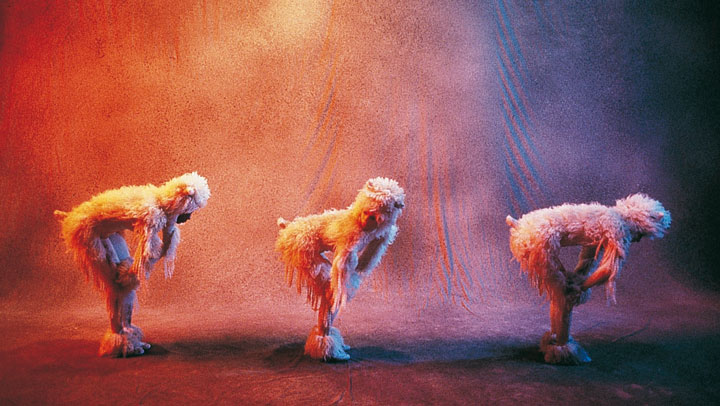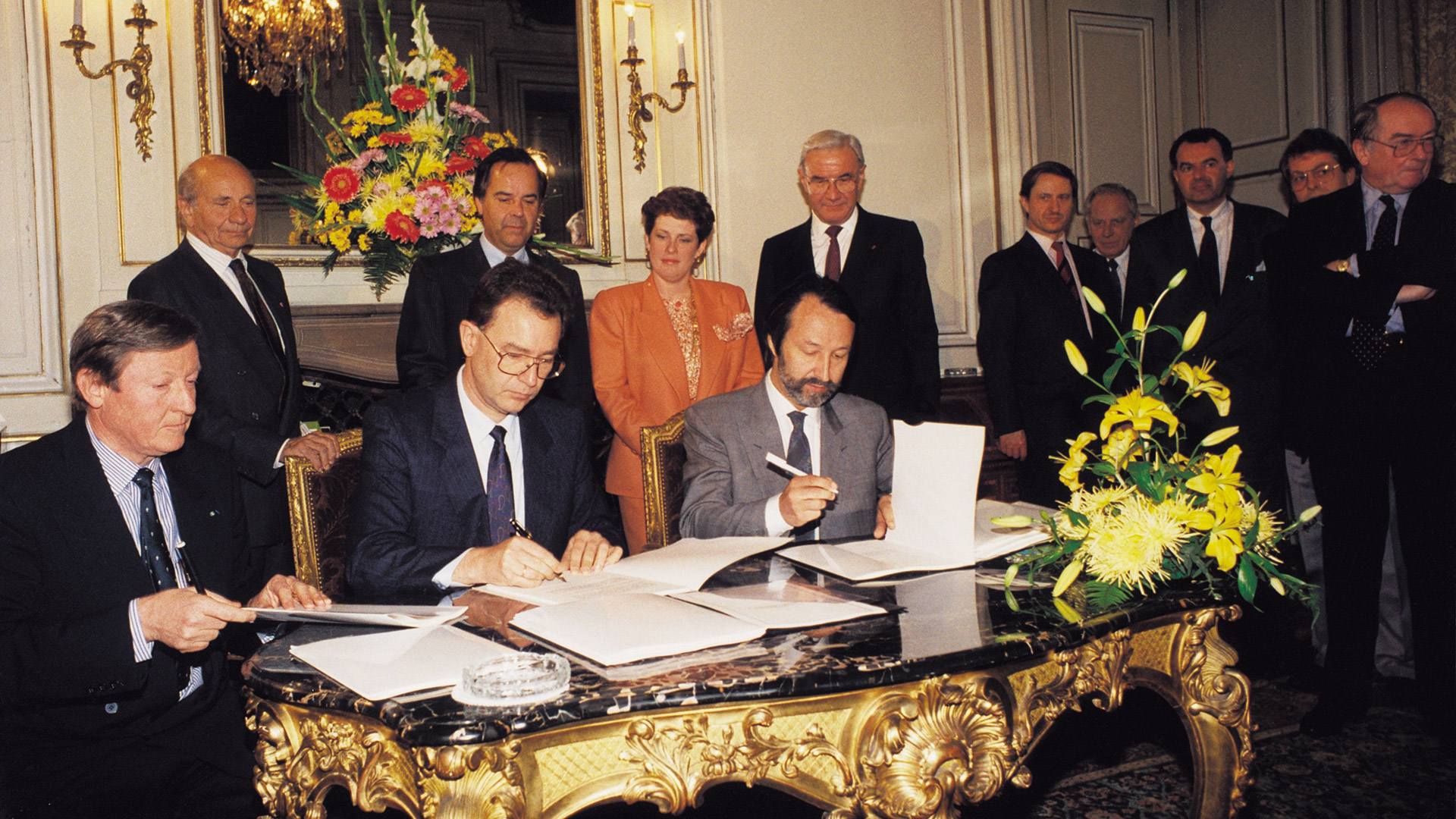
Sheep, programme design by Hélène Guétary, over a soundtrack by Nova/Andrew Orr, 1992
ARTE, the European Culture Channel, is a public broadcaster aimed at curious and open-minded people all over Europe, especially in France and Germany. The creation of a programme for several audiences was a first in the history of television and remains unique in Europe’s audiovisual landscape.
The political will is there from 1988.
The late 1980s was the age of the great European visions, including the single currency, and it was then that the Germans and French declared their intention to create a joint television channel. The idea was to familiarise the Germans and French with each other’s cultures and by bringing them closer to promote further integration.
- 1988: French President François Mitterrand and German Chancellor Helmut Kohl support the concept of a Franco-German culture channel at a Franco-German summit in Bonn. The authorities responsible for such an undertaking, the government of France and the German Länder, agree to look into the possibilities for creating a Franco-German culture channel to be based in Strasbourg.
- 1989: At the end of their talks in Paris, Lothar Späth, Premier of Baden-Württemberg and German plenipotentiary for cultural relations with France, French Culture Minister Jack Lang, and Communications Ministry Delegate Catherine Tasca issue a joint declaration setting out the principle of a Franco-German culture channel.
1991 – ARTE already exists on paper.
The treaty laying the foundations of a European culture channel is signed on the eve of German reunification in October 1990. According to the ARTE statutes of 1991, the new channel is to be 95 % financed out of the licence fees levied in France and Germany. Its structures reflect how broadcasting is organized in the two countries: centralised in France and decentralised in Germany. ARTE is made up of three entities: its headquarters, ARTE G.E.I.E. in Strasbourg, and its two member organizations, ARTE France in Paris and ARTE Deutschland TV GmbH in Baden-Baden. Still more partnership agreements are signed with other public broadcasters such as RTBF in Belgium, ORF in Austria, SRG SSR in Switzerland, or YLE in Finland.
- 2 October 1990: The French Culture Minister and the premiers of all eleven Länder of the former West Germany sign the interstate treaty laying the European Culture Channel’s foundations. The five new Länder of the former East Germany will join the treaty in November 1996. The declared objective is “to establish a common independent television corporation with a cultural and European mission and with head offices in Strasbourg, hereinafter called the ‘European Television Culture Channel’ (EKK), to consolidate understanding and rapprochement between the peoples of Europe [and] offer the people of Europe a common television programme as an instrument for presenting the cultural heritage and artistic life of the states, regions and peoples of Europe and the world.”
- 30 April 1991: The European Culture Channel A.R.T.E. (Association Relative à la Télévisione Européenne) is founded in Strasbourg as a European Economic Interest Grouping (E.E.I.G.) or Groupement Européen d’Intérêt Economique (G.E.I.E.) Made up of one French member, La Sept, and one German member, ARTE Deutschland, it is headquartered in Strasbourg. The inaugural general meeting nominates the following persons to be members of the management board: Jérome Clément, President of La Sept, as President, and Dietrich Schwarzkopf, ARD Director of Programming, as Vice-President; the first Director of Programming is André Harris, and the Administrative Director Winfried Enz. These individuals are entrusted with the mission of “conceiving, creating, and broadcasting or having broadcast […] television programmes with a content that in the broader sense is cultural and international in character and likely to promote understanding and rapprochement between the peoples of Europe.”

Signing of ARTE’s founding treaty 1991 in Strasbourg © Archives de la Ville et de l’Eurométropole de Strasbourg, phot. E. Laemmel
La SEPT (Société d’Edition de Programmes de Télévision), the French ARTE member that in 2000 was renamed ARTE France, was founded in Paris in February 1986 as a joint venture of the regional broadcaster FR3 (45%), the French state (25%), Radio France (15%), and the INA (Institut National de l’Audiovisuel) (15%). It was chaired initially by Georges Duby and Bernard Faivre d’Arcier, and then from 1989 by Jérôme Clément. La SEPT provided ARTE’s initial stock of programmes. The German member, ARTE Deutschland GmbH, was founded in Baden-Baden in March 1991 as a joint venture of Germany’s public broadcasters, ARD and ZDF (50% each).
1992 ARTE goes on air in two languages, reaching three-quarters of all German and French households.
ARTE can be received in most French and German households. As one of the six channels to be broadcast terrestrially in France prior to the switch to ADSL and TNT in the late 1990s, ARTE enjoys high visibility that country. The competition is a lot tougher in Germany, which by then has some thirty channels broadcasting by cable. Having initially broadcast only in the evenings, ARTE becomes a digital pioneer and following the advent of Digital Terrestrial Television in France and cable TV in Germany extends its programme to the whole day.
- 1991: The first employees get down to work at ARTE, which is initially housed at FR3 Alsace in Strasbourg, but in 1992 will move to the rue de la Fonderie. The first programme conference convenes in November 1991.
- 30 May 1992: The inaugural gala is broadcast live from Strasbourg Opera House. The programme starts at 5 p.m. every day and is broadcast on La SEPT and on the regional broadcaster FR3 (Saturday afternoons only) in France and via cable in Germany.
- 28 September 1992: ARTE starts broadcasting terrestrially in France from 7 p.m. every evening, reaching 72% of French households.
ARTE is allocated a 5th frequency, that of the private channel La Cinq belonging to Silvio Berlusconi. This step marks a major advance for the broadcaster, which has hitherto had to rely on transmission via the TDF1 satellite, which only a few households can receive.

